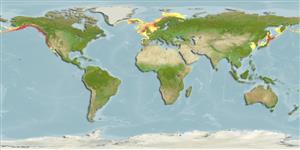Common names from other countries
Environment: milieu / climate zone / depth range / distribution range
Ekologi
; kisaran kedalaman 0 - 60 m (Ref. 127878). Temperate
Pacific Ocean. Temperate to polar.
Length at first maturity / Size / Weight / umur
Maturity: Lm ? range ? - ? cm Max length : 32.5 cm TL jantan/; (Ref. 865)
Valves: Pure white; completely covered by what appears to be coarse maroon leather. Large white valves (Ref. 296).
Fisheries: The foot of the Gumboot Chiton is sometimes eaten in the same manner as the abalone (Ref. 296). Depth ranges from intertidal to 600 m. Inhabits a variety of bottom-types, but prefer stone and pebble (Ref. 290); at some periods in their life cycle, they teem into the intertidal zone (Ref. 339). Often found on the beach (Ref. 296).
Life cycle and mating behavior
Kematangan | Reproduksi, perkembang biakan | Pemijahan | telur-telur | Fecundity | Larva
Members of the class Polyplacophora are mostly gonochoric. Life cycle: Eggs hatch into lecitotrophic planktonic trocophore larvae (no veliger stage) which later metamorphose and settle on the bottom as young adults.
rujukan utama
Acuan | Koordinator | mitra
Burghardt, G. and L. Burghardt. 2006. (Ref. 296)
Status IUCN Red List (Ref. 130435)
status CITES (Ref. 108899)
Not Evaluated
Not Evaluated
penggunaan manusia
Perikanan: memiliki potensi kepentingan
| FishSource |
Alat, peralatan
informasi lanjut
Umur / SaizPertumbuhanpanjang-beratpanjang-panjangMorfologiLarvaKelimpahan
Sumber internet
Estimates based on models
Preferred temperature
(Ref.
115969): 1.5 - 9.9, mean 6 (based on 341 cells).
keancaman
Low vulnerability (20 of 100).
kategori harga
Unknown.
